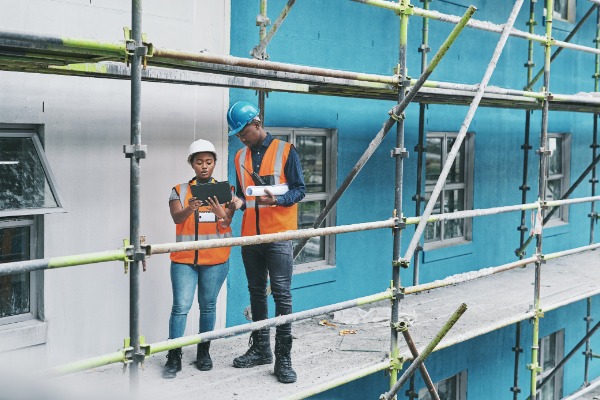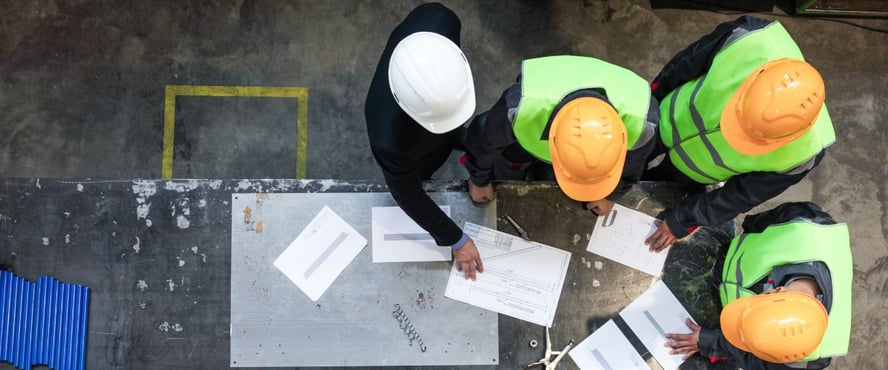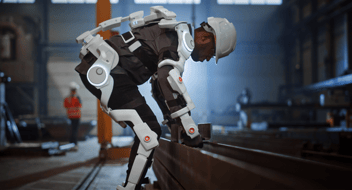
This blog was published in conjunction with RICS World Built Environment Forum.
The pandemic has undoubtedly caused a necessary step change in the way construction professionals think about collaboration and risk.
Construction projects require a serious amount of coordination of people and resources. At the same time, companies must meet the challenges of increasing standards, high levels of competition, and tight margins. Pressure to improve productivity and lower costs must be managed, all the while ensuring the safety of staff onsite.
With the construction industry subject to increasing commercial and competitive pressures, and the growing use of other technologies such as project management information systems and BIM, what additional benefits can the use of mobile technology provide?

Risk and Reward: Managing Complexity in Construction Projects
Technology has always driven construction forward. From the advent of power tools and heavy machinery to the development of wireless functionality and the advancement of BIM and digital twins. But alongside this adoption comes both risk and reward: sites can be more collaborative and productive, and yet more complex and dispersed.
More widely, the adoption of mobile technology across society has seen unprecedented growth in recent years, carrying with it undeniable benefits to people’s day-to-day lives. According to Sensor Tower, year-on-year growth in consumer spending on non-game apps grew by 20% between 2020 and 2021, peaking at $133 billion and nearly matching the 21% year-on-year growth recorded in 2019. With a large proportion of the work and decision-making needing to be made in the field, it seems only natural that mobile technology use in construction should also grow.
Cloud operating systems have seen a healthy level of adoption in construction and can have huge impacts on on-site productivity: McKinsey quote productivity increases associated with its adoption by as much as 50%. The industry has invested more heavily in intangible and technology assets used to manage methods, risk, and controls over the past ten years than ever before, according to KPMG. But perhaps the missing link needed to provide the leap in performance is the functionality to access, share and update data in the common data environment in real-time, in the field. Ultimately, professionals want to engage the tools needed to do their job more effectivity, using the simplest and most efficient tool that they can find.
The success of every construction project is undeniably a combined effort, with all the necessary experts providing their knowledge to complete an element of a project. The associated risk to construction professionals is germane: increasingly fragmented teams and information can result in potentially costly and hazardous mistakes, so the facility to communicate to one another when needed has never been more crucial. Connecting people in remote places with assets, processes, and construction site teams in real- or near real-time can help everyone to work smarter. Mobile technologies allow people to continue working, eliminating the need for costly and polluting trips to and from a central office.

Increasing Standards Need Better Information Management
Health, safety, and environmental standards are forever expanding and getting more detailed, so it’s crucial that mobile applications keep up.
Traditionally, teams working on a construction project would not have much exposure to one another. Members of the team who are predominantly site-based have a key role to play in the success of the project, but this success doesn’t come without the contribution of those working off-site. Whether it’s a full-time office-based employee in head office or someone in the supply chain working in a different country, it makes sense to have the ability for site teams working in the field to raise concerns about, for example, faulty wiring, or waste disposal, as soon as they come across it.
Questions can be asked and answered digitally, without the need for any face-to-face intervention. This ultimately helps provide a more accurate record of the project and achieve a speedier resolution. This can be a critical factor in firms’ capabilities to meet their contractual obligations. In today’s day and age, this is essential to ensuring a project keeps running despite fewer people accessing the site.

Visual, Virtual, and Valuable: Moving Towards More Integrated Applications
Undoubtedly, fear of the unknown, combined with confidence in certain tried and tested ways of working can be a barrier to the adoption of new technologies in construction. But on-site, mobile applications have advanced rapidly in the past 10 years. The question is no longer about whether construction workspaces will digitalize, but by how much, and which strategies they will utilize to keep pace with forever evolving technologies.
Good technology makes life easier. Traditionally, finding and managing hard copy information when on site has been a necessary evil. New platforms that provide seamless cloud collaboration and on-demand access to a central repository of data remove the need to manage hard copy information. This ultimately reduces project risk, allowing construction professionals to focus on the task at hand.
Mobile technologies that capitalize on cloud computing, alongside 5D BIM and augmented reality, will transform the construction industry in the next decade and have the potential to completely change the face and vision of the shared data environment. The interest in digital twins in construction has rapidly grown over the past year, and there have been lots of advancements within mobile technology in terms of hardware. The possibilities are very powerful. Instead of accessing a Common Data Environment and seeing folders containing your data, we may potentially see the shift to the 3D model is the central source of data. In such a model objects can be selected by users and the relevant information would be presented in real-time. Allowing on site professionals access to a digital replica of the building can provide massive benefits to managing the asset through the construction process and post-completion.
Want to learn more about construction technology can improve your projects and boost productivity, download your digital transformation guide now.
Pietro Leo
Vice-President of Operations at Asite
3 minute read
Asite Insights in your inbox.
Sign up for product news and our latest insights published monthly. It's a newsletter so hot, even global warming can't keep up.



